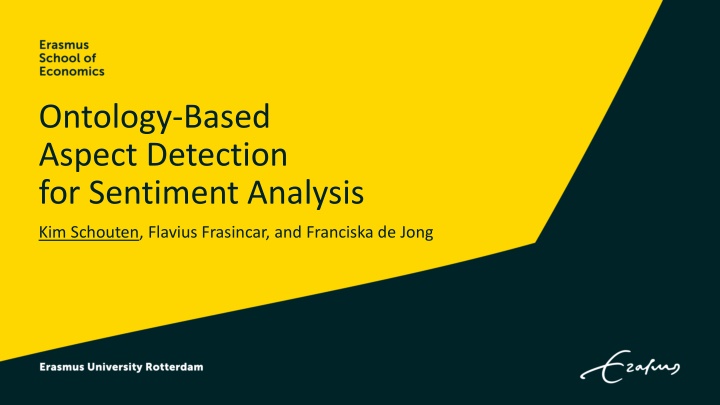
Ontology-Based Aspect Detection for Sentiment Analysis
Learn about the importance of sentiment analysis, why aspect-based analysis is crucial, data snippets, motivation for using external knowledge, and setup details including the use of linear SVM and ontology snippets in sentiment analysis.
Download Presentation

Please find below an Image/Link to download the presentation.
The content on the website is provided AS IS for your information and personal use only. It may not be sold, licensed, or shared on other websites without obtaining consent from the author. If you encounter any issues during the download, it is possible that the publisher has removed the file from their server.
You are allowed to download the files provided on this website for personal or commercial use, subject to the condition that they are used lawfully. All files are the property of their respective owners.
The content on the website is provided AS IS for your information and personal use only. It may not be sold, licensed, or shared on other websites without obtaining consent from the author.
E N D
Presentation Transcript
Ontology-Based Aspect Detection for Sentiment Analysis Kim Schouten, Flavius Frasincar, and Franciska de Jong
What is sentiment analysis? Many people freely express their opinions on the Web Extract sentiment from unstructured text Useful: For consumers when making a purchase decision For producers to assess the impact of marketing campaigns, success of product launches, etc. Many companies in business analytics include some form of sentiment analysis
Why aspect-based? Finer level of analysis Directly link expressed sentiment to actual topic or aspect Useful when topic is not known beforehand, or when there can be multiple topics Two main tasks: 1. Aspect detection 2. Sentiment analysis for aspects
Data Snippet <sentence id="1032695:1"> <text>Everything is always cooked to perfection , the service is excellent , the decor cool and understated .</text> <Opinions> <Opinion target="NULL" category="FOOD#QUALITY" polarity="positive" from="0" to="0"/> <Opinion target="service" category="SERVICE#GENERAL" polarity="positive" from="47" to="54"/> <Opinion target="decor" category="AMBIENCE#GENERAL" polarity="positive" from="73" to="78"/> </Opinions> </sentence>
Why use external knowledge? Using external knowledge alleviates the need for data Good for resource sparse languages / domains Use machine learning for its high performance
Setup Use linear SVM, one for each aspect category Basic linguistic features (lemmas/synsets) Add features based on external knowledge Find concepts based on lexicalization Once concept is found, also add all its superclasses
Results Out-of-sample F Avg. F1 St.dev. In-sample F base 0.575 0.0057 0.803 0.539 +Synsets 0.632 0.0039 0.896 0.5728 +Ontology 0.687 0.0026 0.858 0.613 +Synsets and +Ontology 0.698 0.0040 0.920 0.628
Data size sensitivity analysis Keep the test set the same Use only n% of available training data Set n to 10:100 with step size 10 Performed for both aspect detection and aspect sentiment classification
Conclusions & Future Work
Conclusions External knowledge improves aspect detection for sentiment analysis Better overall performance Less data is needed when using ontology Ontology coverage is important
Bonus slides: Data Analysis
Natural Language Processing Spelling Correction Tokenization Part-of-Speech Tagging Lemmatization Sentence Splitting Word Sense Disambiguation Syntactic Analysis
Ontology as external knowledge An ontology is a formal representation of knowledge usually created manually by domain experts An ontology allows easy sharing of knowledge (e.g. LOD) reasoning to derive (new) facts Our ontology describes a part of the restaurant domain 56 sentiment expressions 3 sentiment values 185 target concepts
